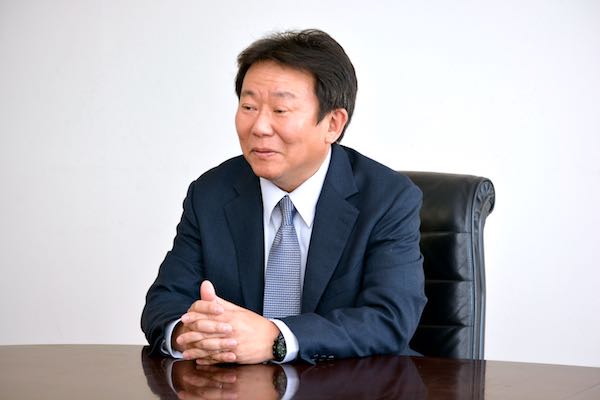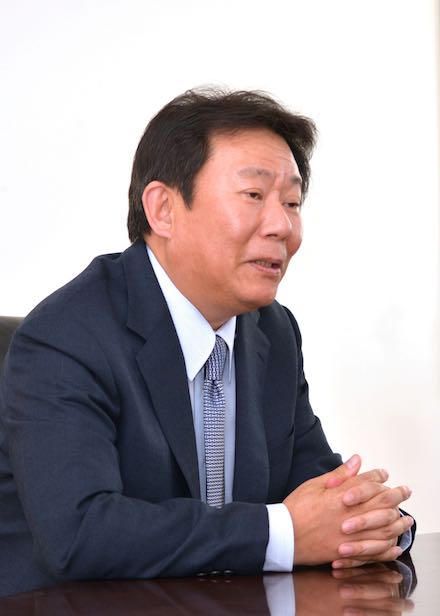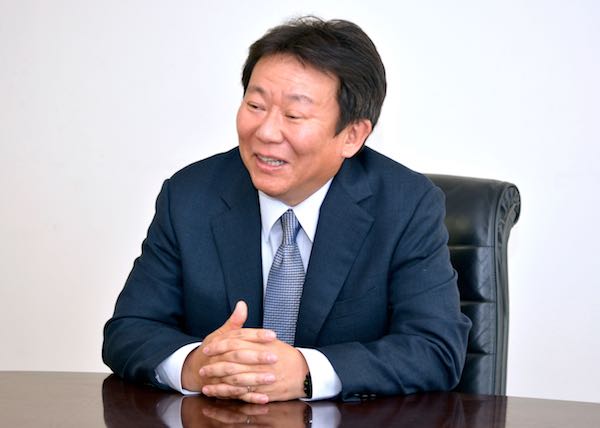President and CEO
Katsumi Uranaka
President Uranaka, who took office on 1st April 2017, spoke to us about future business prospects for Gigaphoton, his expectations for employees and his personal dreams.
With the slogan “Challenge for NEXT Growth”, Gigaphoton is calling the 2016 fiscal year its second period of establishment. Could you tell me about the vision behind these words and the future prospects?

Yes, up until the present time, Gigaphoton’s business scheme has been concentrated on excimer lasers for semiconductor lithography (referred to below as litho-lasers). However, I think that from now on, we will not confine our activities to this but will expand into EUV (Extreme ultraviolet light sources: said to be the next generation light sources for lithography) and expand the new business “GIGANEX” which will apply excimer lasers in fields in which they have not been used before. Last year, EUV reached our long-hoped-for 250 watt output power with 5% conversion efficiency (the output produced per input) and the expectations of customers are getting higher. In 2017 we are planning opportunities to present our EUV to our customers. And, of course, with regard to the new business “GIGANEX”, in March last year we were able to ship our excimer laser for annealing, designed to be used in the new field of FPDs (flat panel displays), and shipping orders have increased since then. In this way, after setting the 2016 fiscal year as our second period of establishment, our challenge is to make litho-lasers, EUV, and GIGANEX the three pillars of the business from which we look to our future growth. Then in July 2017, a new building will be built, which will further increase production capacity. The meaning of our “Challenge for NEXT Growth” would include all these things.
So it seems you can clearly see the vision for the future.
Of course the litho-laser business will be the foundation for the various upcoming challenges, so how do you see it developing now?
Over the past few years, Gigaphoton has received considerable support from customers in the field of excimer lasers for lithography, and has gained over 50% market share worldwide. However, we should not rest on our laurels here, and I’ll always want to review the current situation, repeatedly making improvements (“Kaizen”), and I want to keep doing all I can to provide better products and fast service to customers. Through repeatedly doing all this, I think the customers will come to consider us to be an “essential company”. And I think we will develop a win-win relationship with our customers in which both the company and customer base grow together.
It is said that the lithography market is moving from its growth stage to maturity, so how do you think this will develop?
There are not really any businesses which will continue to grow indefinitely. It is true that the market feels as if it is levelling out but with the IoT and the customer growth as we advance into China, whilst one may say it has reached period of maturity, there are many business chances remaining, so I plan for our company to continue growing without missing any of these opportunities.
What are your thoughts regarding expansion into China?
As I said before, there are many customers making large-scale investments in China, so it is an extremely important market for future growth. In that environment, we must not be late setting up a service foothold to match our customers’ business speed and, through thorough preparation. I hope our support will contribute to our customers achieving smooth production. The speed of business is fast in China so firstly it is important to do all we can to be able to keep up with this.
Now that you are President, what kind of company would you like Gigaphoton to become?

Firstly, I want to make it a company with a feeling for speed. Whatever the situation, I’d like there to be the attitude of “Don’t get stuck thinking about things, get moving and give it a try!” That is to say, use that feeling for speed to charge ahead using trial and error. The reason being that if you move at three times the speed then things can still work even if you fail twice then have to try things over again. For example, if some problem must be cleared in six hours, and you only have one chance, then if you can address it in two hours you will have two opportunities to try things again. If you are fully confident that you can take your time and that things will work then doing it once is enough, but without that confidence it’s best to speed things up and have several attempts. Through that repetition you can say “next time we’ll fix this” or, “then we’ll do it like this”, and all the time you are gaining knowledge and making improvements. This is an important process and I think you can achieve good things as a result. Then another point is the speed of transfer of information. As an organization, the vectors should be well aligned between departments so that communication is as fast as if it were a single department. That’s essential for speedy operation. Particularly in this business world, speed is life. It is often said that “what you sold yesterday is not needed today”. I want everyone always to be aware that companies that are too slow to adapt to changes will not survive.
What is necessary to speed up the transfer of information?
Basically, it’s ensuring the speed of judgement in the managerial staff. Because making judgments is the work of managerial staff. Then when a member of managerial staff can’t make a judgement about some matter it must be quickly directed up to their superior. If that superior can still not make the judgement then it should go up to the next. It is important that this flow is smooth. The particularly important point is how fast the message that “I can’t judge this” is transmitted upwards. This is important not only in business but also from the viewpoint of compliance. Bad information can be like a fire. If a small problem is dealt with quickly in its early stages it can be resolved immediately, but while it is left unattended somewhere, the fire will gain strength rapidly and it is often the case that by the time the problem reaches the top level it has become a major issue. Even if some major problem arises, if the company is one in which information can reach the top level in maybe four hours, for example, things can always be resolved before they become serious. Having that degree of speed for the transfer of information is important. Also, the people who hold the key to this are particularly those colleagues in the managerial positions, and raising skills and awareness of this at these levels is very important.
What kind of expectations do you have for your employees?
Regarding my expectations, I would want them always to carry out their work for the customers with pride and a sense of professionalism whatever their position may be. As they work I want them always to be considering what it is that customers want and what is necessary to raise their level of satisfaction. Other than that, they should always pay attention to issues of health, safety and compliance. I want nobody ever to forget that these basic points are the most important and must come first. That way, the employees of the company can all be satisfied in their work and we can provide an environment that is easy to work in.
Finally, please let me know about your dreams.

I want to go to Antarctica to look at the penguins (laugh). When I was young I was greatly affected by reading Eizaburo Nishibori (Vice Captain of the Primary Japanese Antarctica Survey and Captain of the Wintering Party) so I always wanted to go to the Antarctic. In the past Komatsu used to make snow vehicles for the Antarctic Survey, with staff going out to perform maintenance on them and wondering if I might be able to go along somehow was my main reason for joining them. When I said that in front of the management during my actual company entry tests they told me “Unfortunately, we already have a crew organized for that so it could be difficult” (laugh). Now this will just have to be a trip for me after my retirement but my dream would be to see tens of thousands of wild penguins at close quarters in the Antarctic one day. If I could realize that then I think I’d be taking pictures and getting them up on Facebook (laugh).